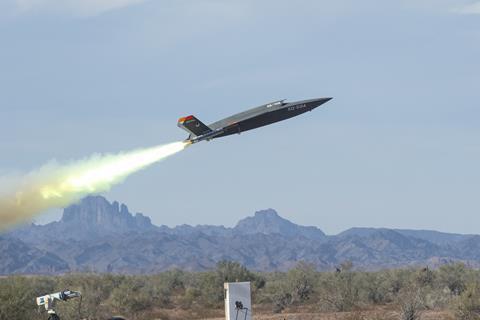The US Air Force’s (USAF’s) Lockheed Martin F-22 Raptor, F-35A Lightning II and the Air Force Research Laboratory’s Kratos Defense XQ-58A Valkyrie flew in formation for the first time on 9 December at the US Army Yuma Proving Ground in Arizona.
The formation flight was part of an attempted demonstration of data transmission between all three aircraft. The F-22 and F-35A successfully shared data using a novel technology called “gatewayONE”, but the XQ-58A was unable to link up, the USAF said on 14 December.

The F-22’s and the F-35’s most-secure communication systems cannot talk directly to one another. (The F-35 uses the Multifunctional Advanced Data Link and the F-22 uses the Intra-Flight Data Link.) The incapability of the fifth-generation fighters’ communication systems causes the Department of Defense (DoD) headaches and forces complex workarounds during operations.
However, the gatewayONE device allowed the data formats to be translated so information could be passed directly between the two aircraft.
“Not only can gatewayONE translate between those formats, in this test it moved data that is normally relegated to an operations center or tactical ground node, directly pushing it into the cockpit at the edge of the multi-domain battlespace for the first time,” says the USAF. “Additionally, the test pushed the position data of each platform outside of the aircraft’s close-proximity formation through gatewayONE, which enables battle managers on the ground or in the air to better orchestrate operations.”
The gatewayONE communications device also “passed tracks or cues from ground operators to both fighters and passed a cue from the F-35A to the F-22 for the first time,” says the service. The information was presented on the aircrafts’ normal displays, it adds.
GatewayONE is part of the USAF’s Advanced Battlefield Management System (ABMS) development programme, an effort to create a military internet-of-things network that will quickly and autonomously pass information around the battlefield. The DoD hopes more information in the hands of pilots, sailors and soldiers will help them spot the enemy quickly and react faster.
“The future is promising, and gatewayONE will allow the F-22 and F-35 to connect to and feed data sources they’ve never before accessed,” says Lieutenant Colonel Eric Wright, a 59th Test and Evaluation Squadron F-35 pilot. “Those future connections will bring additional battlefield awareness into the cockpit and enable integrated fires across US forces.”

As part of the 9 December demonstration flight, the XQ-58A Valkyrie was rocket-launched and made a “semi-autonomous” flight alongside the F22 and F-35 for the first time.
“The gatewayONE payload was integrated into the Valkyrie for its maiden voyage with the fifth-generation fighters to conduct an initial test of gateway capabilities from an attritable platform,” says the USAF. “However, shortly after take off, the communications payloads lost connectivity and those test objectives were unable to be accomplished.”
The demonstration flight programme had 18 test objectives and successfully completed nine, says the USAF.
The service says it also successfully tested the ability of the US Marine Corps’ F-35B to send full-motion video to a ground controller using the Tactical Targeting Network Technology waveform and a Boeing KC-46A Pegasus in-flight refuelling tanker as a communications node.
The service’s tanker fleet will be an important early part of the ABMS network, Will Roper, assistant secretary of the air force for acquisition, technology and logistics, said at an Air Force Association event on 14 December.
“We have already selected ABMS release one, which is a subset of capabilities that make a mini-internet, that gets data from cloud [computing and storage] forward to the tactical edge to our fighters, via mobility gateways and analytics that will be fielded on our tanker fleet,” he says.
The USAF’s dream is to mimic many of the functions of the modern civilian internet, using artificial intelligence and other forms of automation to make fast suggestions to decision makers on the battlefield.
“It’s a microcosm of the internet where the cloud is there, the analytics are there, the tanker is playing the role of a cell tower,” he says. “It’s routing data back and forth between the cloud and users. The users are the fighters that are inside that area denial, communication denial bubble, that are not denied talking with the tanker that is standing just outside of harm’s way.”































